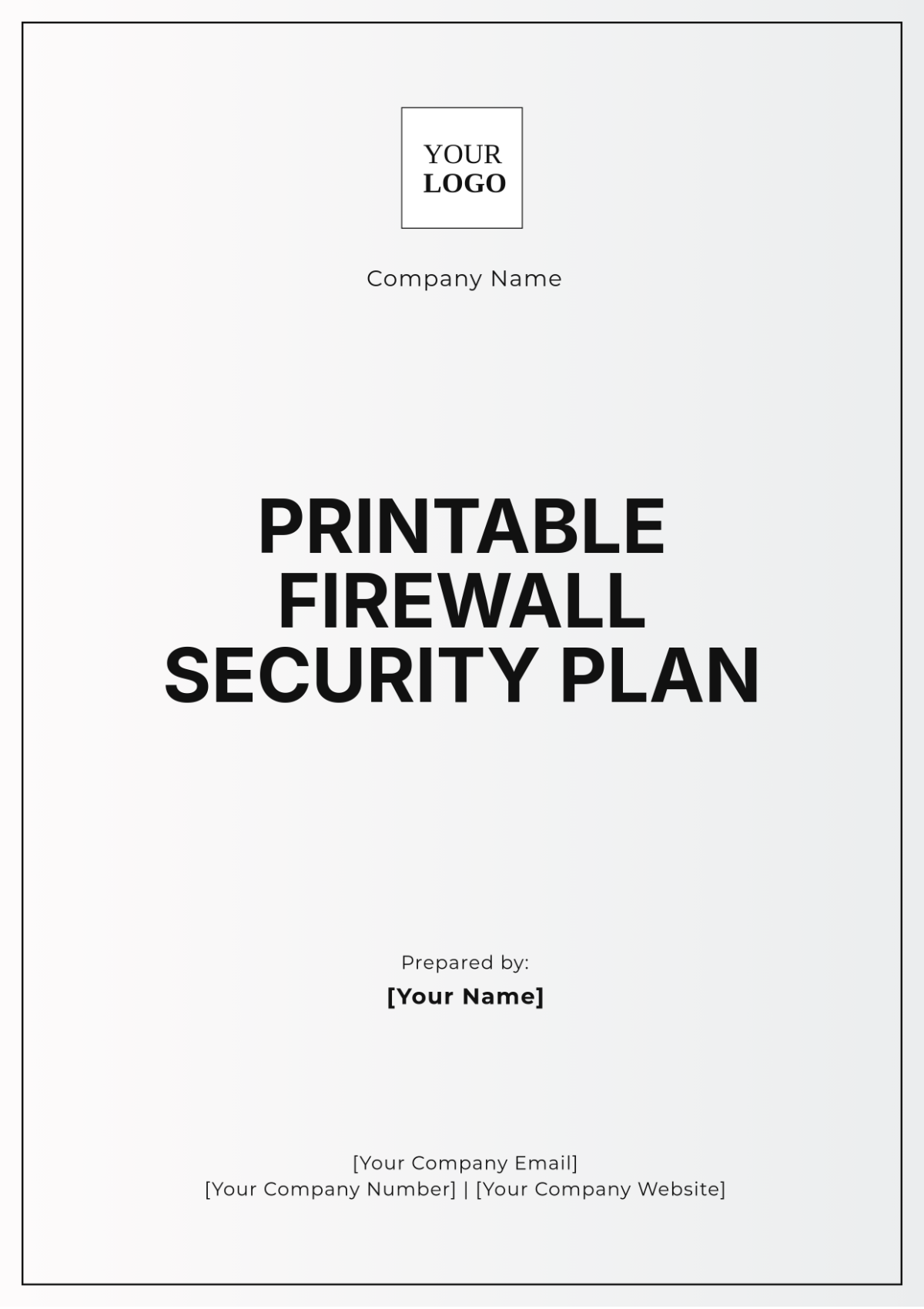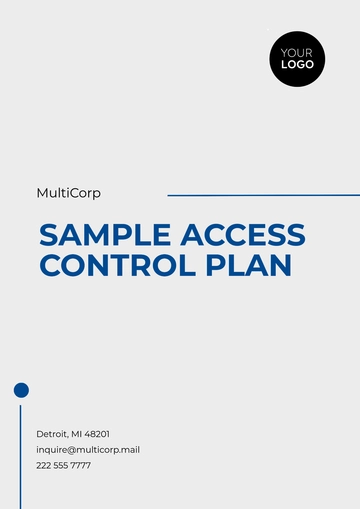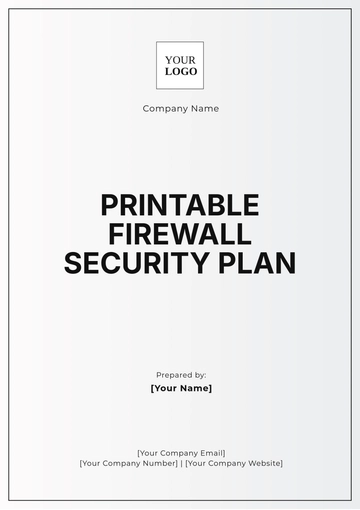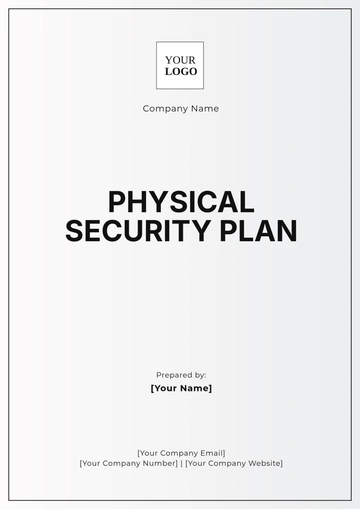Free Printable Firewall Security Plan

I. Introduction
The Firewall Security Plan is designed to protect organizational digital assets from unauthorized access, mitigate potential threats, and ensure network security. This document outlines the strategies, procedures, and technologies implemented to safeguard the network infrastructure.
II. Objectives
Protect all network segments from unauthorized access.
Ensure compliance with industry standards and regulations.
Maintain data integrity and confidentiality.
Provide guidelines for monitoring and managing firewall effectiveness.
III. Firewall Architecture
1. Network Segmentation
Network segmentation divides the network into various segments or subnets, each protected by its own firewall rules. Significant network segments include:
Public-facing Servers
Internal Network
Demilitarized Zone (DMZ)
2. Firewall Types and Placement
Firewall Type | Description | Placement |
|---|---|---|
Packet Filtering Firewall | Checks data packets against pre-defined rules. | Gateway between internal network and internet. |
Stateful Inspection Firewall | Tracks the state of active connections and makes decisions based on the context. | Between internal and external network segments. |
Next-Generation Firewall (NGFW) | Includes traditional firewall functionalities along with additional features like Intrusion Prevention Systems (IPS). | Perimeter of the network. |
IV. Firewall Policy and Configuration
1. Access Control Policies
Define and implement strict access control policies to manage who can access network resources. This includes:
Allow only necessary inbound and outbound traffic.
Implement least privilege access model.
Regular audit of access control lists (ACLs).
2. Rulebase Management
Efficient management of the firewall rulebase is critical. Best practices include:
Regularly review and update firewall rules.
Remove or modify obsolete rules.
Log and monitor rule hits for anomalies.
V. Monitoring and Maintenance
1. Continuous Monitoring
Regular monitoring ensures the early detection of threats and ongoing compliance. Necessary actions include
Implement Intrusion Detection Systems (IDS).
Analyze log files regularly for suspicious activities.
Use automated tools for real-time alerting.
2. Updates and Patch Management
Regular updates and patch management minimize vulnerabilities. Steps to be followed:
Keep firewall firmware and software updated.
Schedule regular maintenance windows.
Test patches in a controlled environment before deployment.
VI. Incident Response
1. Incident Handling
An effective incident response plan is vital to mitigate damage during security events. It should:
Define roles and responsibilities clearly.
Include a communication plan for stakeholders.
Have procedures for incident documentation and analysis.
2. Post-Incident Review
Analyze incidents thoroughly to prevent recurrence.
Perform root-cause analysis.
Implement corrective and preventive measures.
Update policies and procedures based on findings.
VII. Training and Awareness
Regularly train IT personnel and raise awareness among employees about firewall security practices and cyber threats.
VIII. Implementation Timeline
Task | Timeline |
|---|---|
Network Segmentation Setup | Q1 |
Firewall Policy Definition | Q2 |
Training and Awareness Sessions | Q3 |
Incident Response Drills | Q4 |
- 100% Customizable, free editor
- Access 1 Million+ Templates, photo’s & graphics
- Download or share as a template
- Click and replace photos, graphics, text, backgrounds
- Resize, crop, AI write & more
- Access advanced editor
Enhance your cybersecurity strategy with the Printable Firewall Security Plan Template, designed for easy customization to fit your organization’s specific needs. This downloadable and printable template ensures you have a comprehensive plan at your fingertips. Perfect for quick adjustments, it is fully editable in our AI Editor Tool. Ensure your network’s safety with this essential resource, offered by Template.net.
You may also like
- Finance Plan
- Construction Plan
- Sales Plan
- Development Plan
- Career Plan
- Budget Plan
- HR Plan
- Education Plan
- Transition Plan
- Work Plan
- Training Plan
- Communication Plan
- Operation Plan
- Health And Safety Plan
- Strategy Plan
- Professional Development Plan
- Advertising Plan
- Risk Management Plan
- Restaurant Plan
- School Plan
- Nursing Home Patient Care Plan
- Nursing Care Plan
- Plan Event
- Startup Plan
- Social Media Plan
- Staffing Plan
- Annual Plan
- Content Plan
- Payment Plan
- Implementation Plan
- Hotel Plan
- Workout Plan
- Accounting Plan
- Campaign Plan
- Essay Plan
- 30 60 90 Day Plan
- Research Plan
- Recruitment Plan
- 90 Day Plan
- Quarterly Plan
- Emergency Plan
- 5 Year Plan
- Gym Plan
- Personal Plan
- IT and Software Plan
- Treatment Plan
- Real Estate Plan
- Law Firm Plan
- Healthcare Plan
- Improvement Plan
- Media Plan
- 5 Year Business Plan
- Learning Plan
- Marketing Campaign Plan
- Travel Agency Plan
- Cleaning Services Plan
- Interior Design Plan
- Performance Plan
- PR Plan
- Birth Plan
- Life Plan
- SEO Plan
- Disaster Recovery Plan
- Continuity Plan
- Launch Plan
- Legal Plan
- Behavior Plan
- Performance Improvement Plan
- Salon Plan
- Security Plan
- Security Management Plan
- Employee Development Plan
- Quality Plan
- Service Improvement Plan
- Growth Plan
- Incident Response Plan
- Basketball Plan
- Emergency Action Plan
- Product Launch Plan
- Spa Plan
- Employee Training Plan
- Data Analysis Plan
- Employee Action Plan
- Territory Plan
- Audit Plan
- Classroom Plan
- Activity Plan
- Parenting Plan
- Care Plan
- Project Execution Plan
- Exercise Plan
- Internship Plan
- Software Development Plan
- Continuous Improvement Plan
- Leave Plan
- 90 Day Sales Plan
- Advertising Agency Plan
- Employee Transition Plan
- Smart Action Plan
- Workplace Safety Plan
- Behavior Change Plan
- Contingency Plan
- Continuity of Operations Plan
- Health Plan
- Quality Control Plan
- Self Plan
- Sports Development Plan
- Change Management Plan
- Ecommerce Plan
- Personal Financial Plan
- Process Improvement Plan
- 30-60-90 Day Sales Plan
- Crisis Management Plan
- Engagement Plan
- Execution Plan
- Pandemic Plan
- Quality Assurance Plan
- Service Continuity Plan
- Agile Project Plan
- Fundraising Plan
- Job Transition Plan
- Asset Maintenance Plan
- Maintenance Plan
- Software Test Plan
- Staff Training and Development Plan
- 3 Year Plan
- Brand Activation Plan
- Release Plan
- Resource Plan
- Risk Mitigation Plan
- Teacher Plan
- 30 60 90 Day Plan for New Manager
- Food Safety Plan
- Food Truck Plan
- Hiring Plan
- Quality Management Plan
- Wellness Plan
- Behavior Intervention Plan
- Bonus Plan
- Investment Plan
- Maternity Leave Plan
- Pandemic Response Plan
- Succession Planning
- Coaching Plan
- Configuration Management Plan
- Remote Work Plan
- Self Care Plan
- Teaching Plan
- 100-Day Plan
- HACCP Plan
- Student Plan
- Sustainability Plan
- 30 60 90 Day Plan for Interview
- Access Plan
- Site Specific Safety Plan










